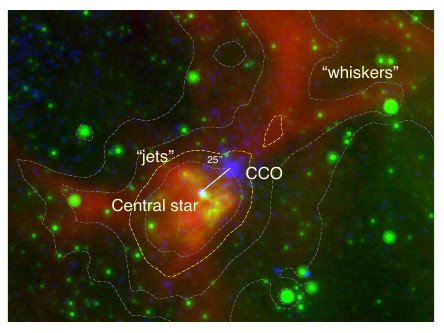 |
| Figure: False-Colour X-ray and infrared emission image from the core of the infrared shell. The RGB colours correspond to Chandra X-ray 0.2-10 keV (blue), IRAC infrared 8 μm (green), and HPACS 70 μm (red) data. The intensity scale is logarithmic for all channels. Overlaid are equal brightness levels from the MIPS 24 μm band. Note that around the CCO the infrared emission is suppressed in the 70 μm band and enhanced in the 24 μm band suggesting higher dust temperature. Credit: Doroshenko et al 2016 |
In a recent paper (Doroshenko et al. 2016) the authors assess that at least in one case the CCO candidate (XMMUJ173203.3-344518) could have been formed within a binary system.
They show that the optical source (IRAS 17287−3443) is surrounded by a dust shell and that the temperature of this infrared shell (heated by the central post-AGB star) increase in the vicinity of the CCO.
They suggest that the dust shell is related to a supernova ejecta because the total dust mass (~ 0.4-1.5 solar masses) significantly exceeds expected dust yields by normal stars.
Based on the morphology of the infrared shell and comparison of its evolutionary timescale with that of the SNR, they conclude that the post-AGB star and the progenitor of the remnant's CCO were likely members of the same binary system disrupted by the supernova explosion.
This could be the first evidence for a binary origin of a CCO.
- Doroshenko et al 2016 (accepted in MNRAS) - Evidence for a binary origin of a central compact object - (arXiv)
Comments
Post a Comment